
Volume XV, Issue XXV
Please Note: THYME will Not Publish Next Week on Christmas, but will Resume Publication on December 31.
The Daring Adventure of Apollo 8
Those three men have carried into space all the resources of art, science, and industry. With that, one can do anything; and you will see that, some day, they will come out all right.” – Jules Verne
Imago Dei, the statement in Genesis that man is indeed created in the image of his Creator, is played out most clearly in the creative impulses and great accomplishments that humankind has risen too. In the Nineteenth Century, Jules Verne envisioned man ‘beating his swords’ not into ploughshares, but into a journey to another world. The Twentieth Century saw just that happen with the terrible weapons of destruction forged into the accomplishment of an actual journey to the moon. Orbiting the moon on Christmas Eve in 1968, the astronauts read the following:
William Anders
We are now approaching lunar sunrise, and for all the people back on Earth, the crew of Apollo 8 has a message that we would like to send to you.
In the beginning God created the heaven and the earth. And the earth was without form, and void; and darkness was upon the face of the deep.
And the Spirit of God moved upon the face of the waters. And God said, Let there be light: and there was light.
And God saw the light, that it was good: and God divided the light from the darkness.
James Lovell
And God called the light Day, and the darkness he called Night. And the evening and the morning were the first day.
And God said, Let there be a firmament in the midst of the waters, and let it divide the waters from the waters.
And God made the firmament, and divided the waters which were under the firmament from the waters which were above the firmament: and it was so.
And God called the firmament Heaven. And the evening and the morning were the second day.”
Frank Borman
And God said, Let the waters under the heaven be gathered together unto one place, and let the dry land appear: and it was so.
And God called the dry land Earth; and the gathering together of the waters called he Seas: and God saw that it was good.”
And from the crew of Apollo 8, we close with good night, good luck, a Merry Christmas – and God bless all of you, all of you on the good Earth. [1.]
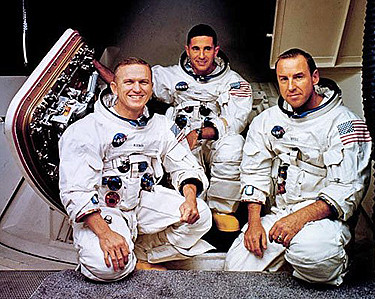
Frank Borman, Willam A. Anders, James A. Lovell.
The crew of Apollo Eight. NASA Photo.
An Improvised Mission
It was a mission that was not in the original plans, but fifty years ago NASA improvised the second manned Apollo flight that orbited the moon ten times. After the successful flight of Apollo Seven in Earth orbit, the next mission was to have been a flight in Earth orbit with the Lunar Module. It would have been an Earth-orbit test of the complete spacecraft’s rendezvous and docking capabilities. But the Lunar Module, the spacecraft that had never been built before – actually TWO spacecraft because it included a descent stage that served as a launch pad for the crew module when it returned to rejoin the Command Module – was still being perfected. Faced with the prospect of no Apollo flights until Spring of 1969, NASA conceived the bold leap of circumnavigating the moon. The mission would examine and identify landing sites for future flights, but it also was important because the deadline set by President Kennedy was fast approaching.
In Russia, Sergei Korolev’s massive N1 rocket was having problems, but the fact that it was being developed had NASA worried that the Soviets would once again score another victory in the high ground of space. With the Lunar Module test bumped to Spring, the decision to orbit the moon was made and Apollo Eight blasted off on December 21, 1968. Two critical burns of the spacecraft’s engine would have to be executed. One would slow it into lunar orbit. After ten orbits, another burn would speed the craft on its return trajectory to Earth. Here the calculations first performed by Katherine Johnson and her colleagues would have to be adhered to perfectly to assure the spacecraft went where it was supposed to. Frank Borman, Jim Lovell and Bill Anders orbited the moon on that historic Christmas Eve and read from the ancient story of Creation. To leave lunar orbit on Christmas Day they would have to fire their engine once more on the far side of the moon, out of communication with Earth. Houston controllers held their breath, then heard Lovell say “Roger, please be informed there is a Santa Claus.” The crew of Apollo Eight were on their way home!

Apollo Eight lifts off. NASA Photo.
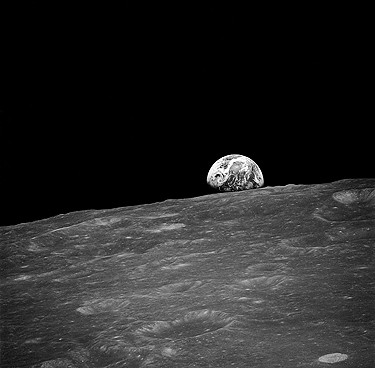
The first Earthrise. NASA Photo.
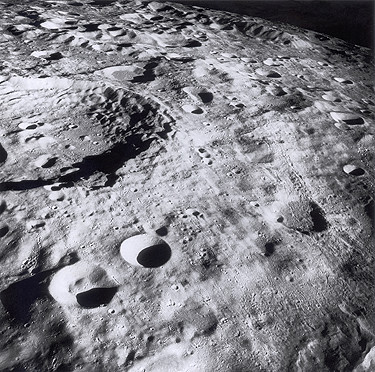
The view orbiting the moon. NASA Photo.

From the Earth to the Moon. NASA Photo.
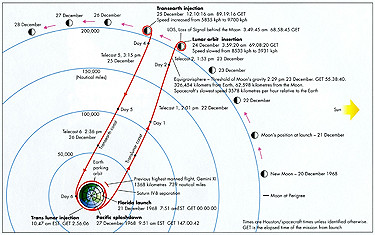
The Triumph of Apollo 8
and Why it Still Matters 50 Years Later
[click to read]
By Richard D. Parker, Ph.D.
This month America celebrates the 50th anniversary of Apollo 8, the first manned flight to the moon. The flight of Apollo 8 marked a redemption not just for the U.S. Space Program but for the belief that failures can be overcome, and victories can be realized. (read more)
Fiftieth Anniversary of Apollo Eight
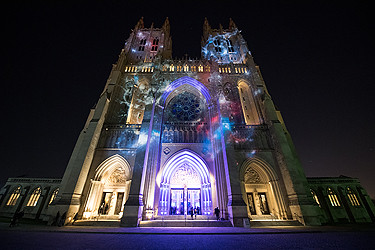
The Washington National Cathedral is seen lit up with space imagery prior to the Smithsonian National Air and Space Museum's Spirit of Apollo event commemorating the 50th anniversary of Apollo 8, Tuesday, Dec. 11, 2018 in Washington, DC. Apollo 8 was humanity's first journey to another world, taking astronauts Frank Borman, Jim Lovell, and William Anders to the Moon and back in December of 1968. Photo Credit: (NASA/Joel Kowsky)
The Spirit of Apollo
2001, A Space Odyssey
Stanley Kubrick's Classic Film
Special Christmas Edition II
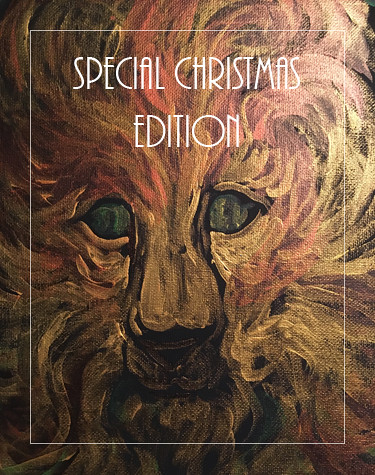
“Lion of Narnia,” Painting by Bob Kirchman.
A Christmas Treasury
Here are presented some of our favorite Christmas features from all time, collected from past issues.
For Unto Us a Child is Born
Isaiah 9:6,7
Why did Jesus Die?
Tchaikovsky's Nutcracker, Op. 71
The Enchanted Nutcracker
What it Has to Do with Christmas
In 1816 German author E. T. A Hoffmann wrote the story Nussknacker und Mausekönig (The Nutcracker and the Mouse King) in which a little girl’s toy nutcracker is really an enchanted prince and her love breaks the enchantment. It is a bit of a dark tale with a seven-headed mouse king and other potentially disturbing elements. Clara is “Marie” in this original tale. Drosselmeyer is a clockmaker and an inventer. The nutcracker is actually Drosselmeyer's nephew, under an enchantment. French author Alexandre Dumas knew of this tale, and the story goes that after he fell asleep at a family party in a chair; The children tied up the sleeping storyteller and when he awoke, they demanded a tale as the price of his release! Dumas basically retold the Hoffman story as a lighter and more whimsical fantasy and later published it as Histoire d'un casse-noisette (The Nutcracker Story) in 1844.
The Dumas version became the basis for the ballet by Tchaikovsky, The Nutcracker, written in 1892. That is when “Marie” became “Clara.” The magical journey is but a dream and the story of unconditional love breaking the spell is forgotten. Still, I think the tale of unconditional love breaking a curse is very appropriate for Christmas, when we celebrate the incarnation of the Divine in the Christ Child, who will free us from the curse of sin. It is, as C. S. Lewis would say, another example of myth pointing to great truth.
A Beloved Christmas Story's Story
With Six Children to Feed, the Author Needed a Miracle

Frances Alexander's 1842 painting of the famous author.
The Year was 1843 and he needed a miracle. With six children to feed and a large house in London to maintain, his slipping sales as a writer were of great concern. His installment novel: Martin Chuzzlewit, was selling poorly, unlike earlier works like Nicholas Nickleby, which had given him some measure of success.
Christmas was coming as he bitterly confided to a friend that his checkbook was empty. Walking the streets, he came up with a 'Ghost of an Idea' and set to work. He published 6000 copies in time for Christmas distribution. They sold out, but because he had splurged on hand-coloured illustrations by John Leech he barely broke even. [1.] Yes, even in Nineteenth Century England, good illustration cost you something! [2.]
Fortunately the little work went on to be a classic. It reinvigorated the career of its creator. Today we still love A Christmas Carol and its author: Charles Dickens, not only as a writer, but as one who helped to bring about much needed social reforms in his day.
Stille Nacht, Heilige Nacht
Beloved Carol Inspired by a Broken Organ
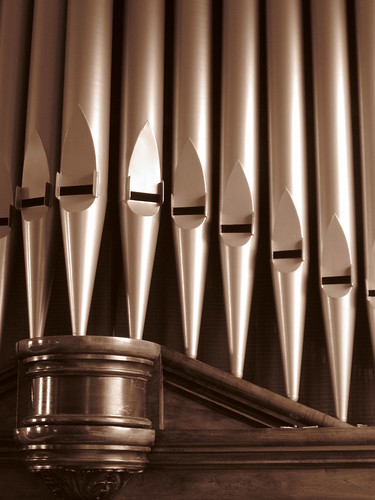
The pipes of the Trinity Lutheran Church organ in Crimora.
Lynn [click to read] brings us the wonderful story of how one of our most beloved carols came to be written:
In 1818, a roving band of actors was performing in towns throughout the Austrian Alps. On December 23 they arrived at Oberndorf, a village near Salzburg where they were to re-enact the story of Christ's birth in the small Church of St. Nicholas.
Unfortunately, the St. Nicholas' church organ wasn't working and would not be repaired before Christmas. Because the church organ was out of commission, the actors presented their Christmas drama in a private home. That Christmas presentation of the events in the first chapters of Matthew and Luke put assistant pastor Josef Mohr in a meditative mood. Instead of walking straight to his house that night, Mohr took a longer way home. The longer path took him up over a hill overlooking the village.
From that hilltop, Mohr looked down on the peaceful snow-covered village. Reveling in majestic silence of the wintry night, Mohr gazed down at the glowing Christmas-card like scene. His thoughts about the Christmas play he had just seen made him remember a poem he had written a couple of years before. That poem was about the night when angels announced the birth of the long-awaited Messiah to shepherds on a hillside.
Mohr decided those words might make a good carol for his congregation the following evening at their Christmas eve service. The one problem was that he didn't have any music to which that poem could be sung. So, the next day Mohr went to see the church organist, Franz Xaver Gruber. Gruber only had a few hours to come up with a melody which could be sung with a guitar. However, by that evening, Gruber had managed to compose a musical setting for the poem. It no longer mattered to Mohr and Gruber that their church organ was inoperable. They now had a Christmas carol that could be sung without that organ.
On Christmas Eve, the little Oberndorf congregation heard Gruber and Mohr sing their new composition to the accompaniment of Gruber's guitar.
Weeks later, well-known organ builder Karl Mauracher arrived in Oberndorf to fix the organ in St. Nicholas church. When Mauracher finished, he stepped back to let Gruber test the instrument. When Gruber sat down, his fingers began playing the simple melody he had written for Mohr's Christmas poem.
Deeply impressed, Mauracher took copies of the music and words of "Stille Nacht" back to his own Alpine village, Kapfing. There, two well-known families of singers — the Rainers and the Strassers — heard it. Captivated by "Silent Night," both groups put the new song into their Christmas season repertoire.
Stille Nacht, heilige Nacht,
Alles schläft; einsam wacht
Nur das traute hochheilige Paar.
Holder Knabe im lockigen Haar,
Schlaf in himmlischer Ruh!
English translation:
Silent night! holy night!
All is calm, all is bright,
'Round yon virgin mother and Child!
Holy Infant, so tender and mild,
Sleep in heavenly peace,
Sleep in heavenly peace.
The Strasser sisters spread the carol across northern Europe. In 1834, they performed "Silent Night" for King Frederick William IV of Prussia, and he then ordered his cathedral choir to sing it every Christmas eve.
Twenty years after "Silent Night" was written, the Rainers brought the song to the United States, singing it (in German) at the Alexander Hamilton Monument located outside New York City's Trinity Church.
In 1863, nearly fifty years after being first sung in German, "Silent Night" was translated into English (by either Jane Campbell or John Young). Eight years later, that English version made its way into print in Charles Hutchins' Sunday School Hymnal. Today the words of "Silent Night" are sung in more than 300 different languages around the world.
The English version we know today was written by the Episcopal priest John Freeman Young, however the standard English version contains just three verses, whereas the German version contains six. (only verses 1, 6 and 2 from the original Joseph Mohr version are sung in English).
The Story of 'Joy to the World'
A Beloved Hymn Written in Celebration of Advent

Graphic by Kristina Elaine Greer, who writes: "I overlaid the entire picture from photos I took of the music in the most recent United Methodist Hymnal. I simply clipped out the music part and compiled them together then cut and pasted them to the template and changed the opacity."
A Short History of 'Joy to the World'
by Kristina Elaine Greer
Most people think of the wonderful hymn, “Joy to the World,” as Christmas Hymn proclaiming the joy of Christ’s birth, but there is a different history behind this marvelous song. The original words to “Joy to the World” by English hymn writer Isaac Watts were based on Psalm 98 in the Bible. According to Wikipedia “the song was first published in 1719 in Watts' collection; The Psalms of David: Imitated in the language of the New Testament, and applied to the Christian state and worship.” Isaac Watts originally wrote the words of "Joy to the World" as a hymn glorifying Christ's triumphant return stated in the book of revelation, instead of as a song celebrating the birth of Jesus Christ. This song was meant more for Advent than Christmas and in some hymnals today you will find it in the holiday concordance of the hymnal under Advent instead of Christmas (which is correct). Interestingly, we only sing the second half of Watts' lyrics when we sing this beloved hymn. The music of this song was adapted and arranged to Watts' lyrics by Lowell Mason in 1839. The melody is said to have been from an older melody, which was then believed to have originated from Handel, partially because of the theme of the refrain (And heaven and nature sing...). This appears in the beloved orchestra opening and accompaniment of the “Comfort ye” from Handel's Messiah, the first four notes match the beginning of the choruses “Lift up your heads” and “Glory to G-d” from the same oratorio. Handel, however, did not compose the entire tune. In fact “Antioch” is the generally used name of the tune. As of the late 20th century, “Joy to the World” was the most-published Christmas hymn in North America. Today we still enjoy it during the holiday seasons of Advent and Christmas time no matter the history it reminds us to be joyful that we have a Savior, who came to earth as a baby, lived among us, died for us, was raised again victorious, and is our Lord who will come again in glorious acclamation.
Unpacking The Twelve Days of Christmas
You Will Never Look at this Song the Same Way Again

"Partridge."
I always assumed the song: "The Twelve Days of Christmas" to be a simple frivolous song of celebration. Not so!, this song is instructive in basic truths of the Christian Faith! Here is the explanation by Father Edward Dowling:
“The Twelve Days of Christmas” celebrates the official Christmas season which starts liturgically on Christmas Day and ends twelve days later on the Feast of the Epiphany. “My true love” refers to God, “me” is the individual Catholic. The “twelve lords a leaping” are the twelve basic beliefs of the Catholic Church as outlined in the Apostles Creed. The “eleven pipers piping” are the eleven Apostles who remained faithful after the treachery of Judas. The “ten ladies dancing” are the Ten Commandments. The “nine drummers drumming” are the nine choirs of angels which in those days of class distinction were thought important. The “eight maids a milking” are the Eight Beatitudes. The “seven swans a swimming” are the Seven Sacraments (or the Seven Gifts of the Holy Spirit) [click to read]. The “six geese a laying” are the Six Commandments of the Church or the six days of creation. The “five golden rings” are the first five books of the Old Testament called the Torah which are generally considered the most sacred and important of all the Old Testament. The “four calling birds” are the Four Gospels. The “three French hens” are the Three Persons in God or the three gifts of the Wise Men. The “two turtle doves” represent the two natures in Jesus: human and divine or the two Testaments, Old and New. The “partridge” is the piece de resistance, Jesus himself, and the “pear tree” is the Cross."
Here is More Historical Background [click to read] from Father Dowling. h/t Kristina Elaine Greer G-d bless you all during the Advent, Christmas, and Epiphany seasons!
Sherando Lake Island and Ice

The island in Sherando Lake. This photo is displayed in the Virginia Blood Services Waynesboro Facility.
Photo by Bob Kirchman
Photos from THYME and The Journey are available through The Kirchman Studio [click to read]. Please contact them directly if you are interested.
The Wonder of Christmas

“Aslan Sings Narnia’s Creation, A Reference to The Magician’s Nephew by C. S. Lewis.” Painting By Madeline Maas.
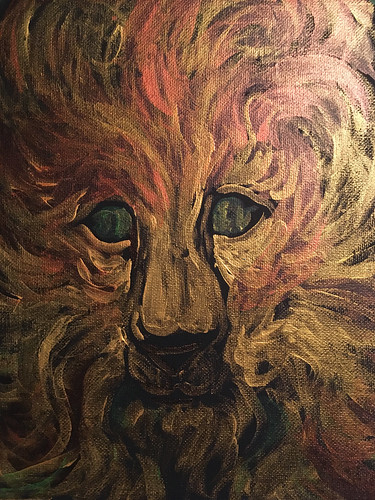
“Lion of Narnia.” Painting by Bob Kirchman.
LITTLE lamb, who made thee?
Dost thou know who made thee,
Gave thee life, and bade thee feed
By the stream and o'er the mead;
Gave thee clothing of delight,
Softest clothing, woolly, bright;
Gave thee such a tender voice,
Making all the vales rejoice?
Little lamb, who made thee?
Dost thou know who made thee?
Little lamb, I'll tell thee;
Little lamb, I'll tell thee;
He is called by thy name,
For He calls Himself a lamb;
He is meek and He is mild,
He became a little child.
I a child and thou a lamb,
We are called by His name.
Little lamb, God bless thee!
Little lamb, God bless thee!
--WILLIAM BLAKE
LITTLE one, who straight hast come
Down the heavenly stair,
Tell us all about your home,
And the father there."
He is such a one as I
Like as like can be.
Do his will, and, by and by,
Home and him you'll see."
--GEORGE MACDONALD
The Son of God became a man to
Enable men to become sons of God.”
--C. S. LEWIS
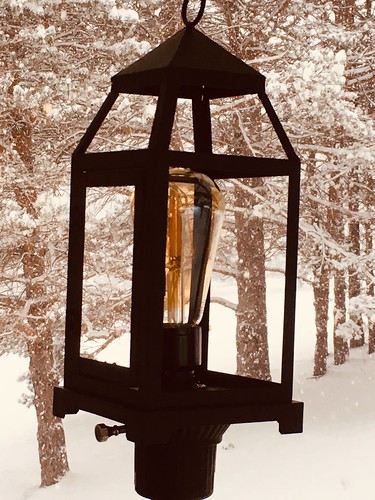
Narnia Lamppost. Bob Kirchman.
“You Saved 1968”
The Legendary Telegram
The year 1968 was a difficult one. The war in Vietnam raged on. At home Dr. Martin Luther King’s assassination and that of Bobby Kennedy made for uncertain times. We forget sometimes that the 1960s were a time when our nation was divided in so many ways and the threat of Soviet military might loomed heavy over us. It was in that time that President John Kennedy artfully redirected our space program into a civilian program that would muster the best in us for a lofty endeavor. He challenged us to go to the moon.
For years we played catch-up with the Russians, but on Christmas Eve, 1968, three American Astronauts read from Genesis as they orbited the moon. They were the first humans to fly into deep space and circumnavigate another world. Fifty years ago they charted a course to a place where man had never ventured before and for a brief moment they brought us all together. It is reported that they received an anonymous telegram summing up what their mission meant to a watching world. In an interview, the Astronauts put it in these words:
Lovell: I think that Bill got this telegram that said what, "You made 1968."
Borman: Saved.
Anders: Right.
Lovell: "You saved 1968."
